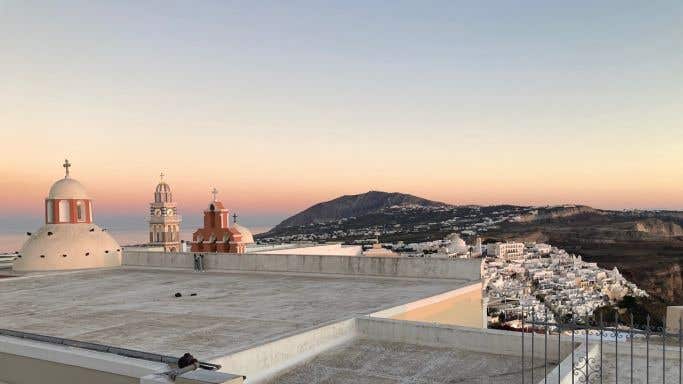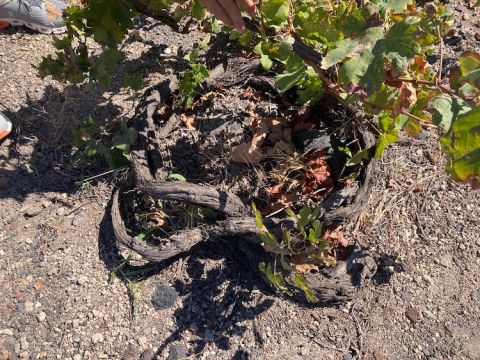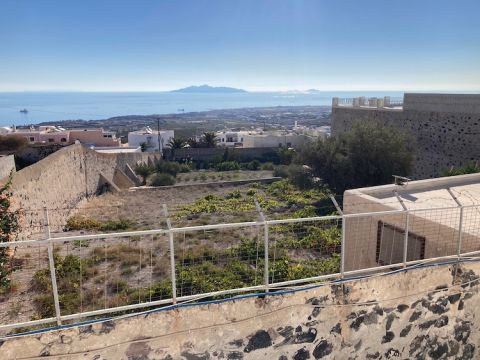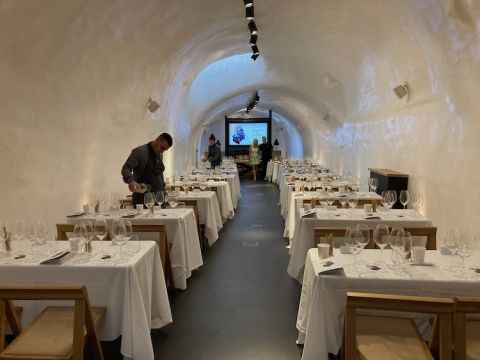Not all wine grapes are created equal. A version of this article about one very special one is published by the Financial Times. See also Awesome Assyrtikos for much more information and 91 tasting notes, mainly on Assyrtikos.
Assyrtiko, the characteristic grape of the hauntingly firm, fumy dry whites of the volcanic Greek island of Santorini, is an obvious example of a lesser-known grape variety that, once tasted, is never forgotten. It magically combines something saline and mineral with something citrus as well as tension and a magical ability to develop even more complexity in bottle even though growing seasons in its homeland are notoriously hot, almost impossibly dry, and inhospitably windy.
Santorini, with its unforgettable sunsets and whitewashed towns clinging to cliffs of dark lava, is above all a holiday island, half a million arrivals at the international airport a year apparently unfazed by the fact that the last eruption was less than 70 years ago. From May to October, while these ancient vines crawl around in a traditional basket shape only a few inches off the arid ground to avoid the worst of the wind, the island’s narrow roads are choked with hotel transfers and rented quad bikes. Vines have had to compete with developers to stay in the ground.
But when Australian winemaker Peter Barry of Jim Barry Wines in Clare Valley sipped his first Assyrtiko over a lunch on the island in 2006 he was convinced that if it could produce such intense, crisp, absorbing wine on Santorini, it would probably thrive back home in South Australia too. The next year, when he was at the London Wine Fair, he made it his business to taste as many Assyrtikos as possible and was so impressed that he was prepared to go through the complicated business of getting the vine variety, completely new to Australia, through many years of quarantine before being planted there. The first commercial vintage of Jim Barry Assyrtiko was 2015 and the wine goes from strength to strength.
At more or less the same time South Africa’s famous vine nurturer Rosa Kruger, concerned that Cape grapes were losing crucial acidity, toured Europe with a view to identifying Mediterranean grape varieties that thrive in a hot, dry climate. She brought back bottles of wines made from a range of grapes, including Assyrtiko and the Spanish varieties Mencía and Viura, to taste with the team at the official Cape vine nursery Vititec. They were sufficiently impressed by the Assyrtikos to import cuttings – better quality than the reference samples already in the national vine collection at Nietvoorbij in Stellenbosch – and embark on South Africa’s long quarantine process.
The eventual result is that South Africa’s first commercial Assyrtikos have just been released by Jordan winery and by Chris and Andrea Mullineux. According to Chris Mullineux, ‘we planted the Assyrtiko along with Macabeo, Verdelho, Vermentino and a few other varieties, and it has been the Assyrtiko which has excited us most so far as a standalone variety. The other varieties have a lot of interest as components for blending (the Verdelho for example has an incredible acidity), but it's the Assyrtiko which was just beautiful, complex and complete on its own – textured and fresh with lovely aromatics at normal ripeness.’
The Mullineuxs’ Swartland neighbour Eben Sadie, arguably an even more famous new-wave producer than them, has also planted many of these Mediterranean imports for inclusion in his renowned blends and reports that the Assyrtiko he has planted in the Paardeberg and on the west coast in St Helena Bay is already ‘showing immense promise’.
Alois Lageder in Alto Adige and Dafermou winery in Cyprus have both produced an Assyrtiko. In the US Assyrtiko was added to the University of California’s vine-variety collection as long ago as 1948 but it has taken decades for it to catch on. 2021 was the first harvest for both the regeneratively managed Paicines Ranch Vineyard in San Benito County south of San Francisco and Greek grape-grower Perlegos in Lodi to the north. Well north of Lodi the Trappist New Clairvaux Abbey and Hiyu Wine Farm in the windy Columbia Gorge in the Pacific Northwest grow some too. And, as Michael Karam points out in What Lebanese wine needs, Assyrtiko is now being grown successfully in Lebanon.
But perhaps the most surprising example of its being valued outside its homeland is that, according to producer Charles Philipponnat, Assyrtiko has proved one of the most successful imported vine varieties to have been trialled by the authorities in Champagne. I spent a few days on the island in September and tasted evidence that Assyrtiko can indeed make very respectable sparkling wine.
Assyrtiko is so good at hanging on to its high acidity, even in high-alcohol wines, it’s not surprising that when a cohort of sophisticated and ambitious winemakers emerged in Greece at the end of the last century, many of them on the mainland and other islands wanted to try their hands at Assyrtiko. Blends with international varieties such as Biblia Chora’s Sauvignon Blanc/Assyrtiko were seen as a way to introduce the stranger from Santorini.
Greek mainland Assyrtiko tends to be fruitier and less finely etched than that grown on Santorini where the exceptional age of so many vines, or at least the roots onto which younger cuttings have been grafted, is presumably a major factor. Master of Wine Yiannis Karakasis claims 34 centuries of vine-growing on the island in his rather mouth-watering book The Wines of Santorini. About 60% of the nearly 2,000 ha (4,940 acres) of Assyrtiko grown in Greece is either on Santorini, often called Thira, or on the much smaller volcanic island off its north-west tip, Thirasia.
Because of the age of the vines here, the whipping wind, almost non existent soils of pumice and lava on a base of schist and limestone, yields are tiny: sometimes as little as 5 hl/ha (around 0.3 ton/acre). A year in which yields reach 20 hl/ha is regarded as bounteous. Hence the prices.
I was on the island to witness the Vedema wine festival at Selene restaurant in one of the island’s many monasteries that have been converted into atmospheric hotels – a by no means painful way to spend a late-September weekend. On Saturday afternoon wine lovers from all over Greece and beyond took advantage of a walk-round tasting of 68 Santorini wines in the building’s arched white tunnel that had been the monastery’s canava, the local word for a winery or wine cellar (see below). Although the majority of the wines were searingly pure, dry, unoaked Assyrtikos, there were also examples of the oaked style called Nykteri (not always as successful), and the dark, sweet, traditional Vinsanto made from sun-dried grapes.
Some of the wines included small portions of the island’s other best-known pale-skinned grapes Athiri and Aïdani, and there were quite a few reds made from the island’s characteristic dark-skinned grape Mavrotragano that were not bad at all but lacked the sheer class of Assyrtiko.
The day before there had been two extremely revealing masterclasses. In the morning, German Master of Wine Caro Maurer showed a range of Rieslings alternating with Assyrtikos, a replay of a comparative tasting held in Athens in 2019. Like Assyrtiko, Riesling is famous for its high acidity and ability to age and I have long held that it is the world’s greatest white wine grape (to little effect on Riesling sales). At the end of each of these Riesling v Assyrtiko presentations, Maurer and Karakasis served one Assyrtiko and one Riesling blind. They deliberately chose very similar styles and it was next to impossible to be sure which was which.
In the afternoon Karakasis presented 10 very lively, older dry white Assyrtikos – from 2016 back to 2012 – and a couple of Vinsantos, one of which was made in 1947 and is still delicious. He claims to have tasted a mid-19th-century Assyrtiko that was alive and kicking. I believe him.
Thrilling dry white Assyrtikos
Santorini
See the Santorini online store, which offers worldwide delivery.
Anhydrous, Icon 2021 14.2%
Argyros 2020 14.5%
£29.50 Tanners Wine Merchants
Gaia, Ammonite 2020 14%
£54.70 Epinoia
Gavalas 2020 14%
Mikra Thira 2020 13.5%
£42 Cava Spiliadis Collection
Mikra Thira, Terrasea 2020 13.3%
£78 Cava Spiliadis Collection
Oeno P, Tria Ampelia 2020 14.5%
Argyros, Cuvée Evdemon 2019 15%
Argyros, Cuvée Monsignori 2019 14.5%
£36.75 NY Wines
Gavalas, Enalia 2019 14.6%
Hatzidakis, Skitali 2018 14%
£49.95 Wine & Greene
Volcanic Slopes Vineyards, Pure 2018 13.5%
Argyros, Cuvée Evdemon 2017 14.5%
Argyros, Cuvée Monsignori 2017 14%
Sigalas 2017 14.5%
Tselepos Canava Chryssou 2015 14%
Volcanic Slopes Vineyards, Pure 2015 13.5%
Argyros 2013 13.5%
Elsewhere
T-Oinos, Clos Stegasta Rare (all vintages) Cyclades 14%
Jim Barry 2020 Clare Valley 12.5%
£21.50 Tanners Wine Merchants
Tasting notes in our database. International stockists (such as they are so far) on Wine-Searcher.com.





